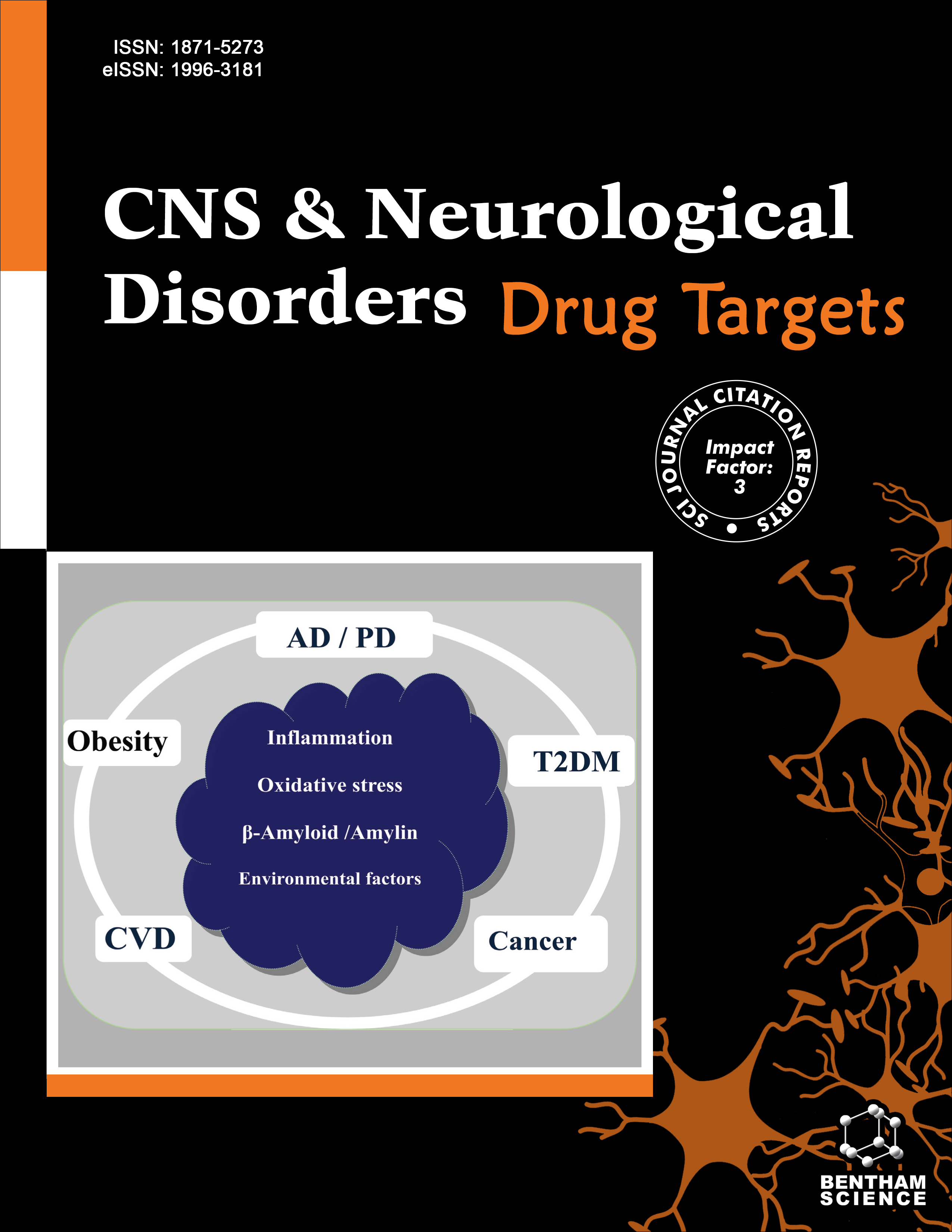- Home
- A-Z Publications
- CNS & Neurological Disorders - Drug Targets (Formerly Current Drug Targets - CNS & Neurological Disorders)
- Previous Issues
- Volume 21, Issue 7, 2022
CNS & Neurological Disorders - Drug Targets (Formerly Current Drug Targets - CNS & Neurological Disorders) - Volume 21, Issue 7, 2022
Volume 21, Issue 7, 2022
-
-
Molecular and Biochemical Pathways Encompassing Diabetes Mellitus and Dementia
More LessDiabetes mellitus is a major metabolic disorder that has now emerged as an epidemic, and it affects the brain through an array of pathways. Patients with diabetes mellitus can develop pathological changes in the brain, which eventually take the shape of mild cognitive impairment, which later progresses to Alzheimer’s disease. A number of preclinical and clinical studies have demonstrated this fact, and molecular pathwa Read More
-
-
-
Mechanisms Involved in Neuroprotective Effects of Transcranial Magnetic Stimulation
More LessTranscranial Magnetic Stimulation (TMS) is widely used in neurophysiology to study cortical excitability. Research over the last few decades has highlighted its added value as a potential therapeutic tool in the treatment of a broad range of psychiatric disorders. More recently, a number of studies have reported beneficial and therapeutic effects for TMS in neurodegenerative conditions and strokes. Yet, despite its recognised Read More
-
-
-
Neurodegenerative Disorders and the Current State, Pathophysiology, and Management of Parkinson’s Disease
More LessAuthors: Rahul and Yasir SiddiqueIn the last few decades, major knowledge has been gained about pathophysiological aspects and molecular pathways behind Parkinson’s Disease (PD). Based on neurotoxicological studies and postmortem investigations, there is a general concept of how environmental toxicants (neurotoxins, pesticides, insecticides) and genetic factors (genetic mutations in PD-associated proteins) cause depletion of dopamine from substantia Read More
-
-
-
Tremor and Rigidity in Patients with Parkinson’s Disease: Emphasis on Epidemiology, Pathophysiology and Contributing Factors
More LessAuthors: Shivam Kumar, Lav Goyal and Shamsher SinghParkinson's disease (PD) is the second most prominent neurodegenerative movement disorder after Alzheimer’s disease, involving 2-3% of the population aged above 65 years. This is mainly triggered by the depletion of dopaminergic neurons located in substantia nigra pars compacta (SNpc) in the region of basal ganglia. At present, diagnosis for symptoms of PD is clinical, contextual, unspecified and therapeutically inc Read More
-
-
-
Strategic Approaches to Target the Enzymes using Natural Compounds for the Management of Alzheimer’s Disease: A Review
More LessAuthors: Syed S. Ahmad, Kaiser Younis, Jeandet Philippe, Michael Aschner and Haroon KhanAlzheimer's Disease (AD) is a chronic neurodegenerative disease. It is clinically characterized by memory loss and intellectual decrease, among other neurological deficits. The etiology of AD is not completely understood but includes amyloid plaques and intracellular helical filaments as well as neurofibrillary tangles with hyperphosphorylated tau protein. AD is also associated with alterations in amyloid processing genes, such Read More
-
-
-
Clinical Efficacy of Cerebrolysin and Cerebrolysin plus Nootropics in the Treatment of Patients with Acute Ischemic Stroke in Vietnam
More LessAims: To investigate the efficacy and safety of Cerebrolysin and Cerebrolysin plus nootropics in the routine treatment of patients with acute ischemic stroke (AIS). Background: Acute ischemic stroke (AIS) is a leading cause of disability with unmet treatment needs lacking effective drug therapy. Multimodal drugs modulating stroke pathophysiology as Cerebrolysin constitute a good therapeutic option. Objective: In this stu Read More
-
-
-
Rolipram Rescues Memory Consolidation Deficits Caused by Sleep Deprivation: Implication of the cAMP/PKA and cAMP/Epac Pathways
More LessAuthors: Ahmed Maher, Nesrine El Sayed, Heba Nafea and Mohamed GadBackground: Over the last few years, the number of people suffering from sleeping disorders has increased significantly despite negative effects on cognition and an association with brain inflammation. Objectives: We assessed memory deficits caused by Sleep Deprivation (SD) to determine the therapeutic effect of phosphodiesterase 4 (PDE4) inhibitors on SD-induced memory deficits and to investigate whether the modulation o Read More
-
Volumes & issues
-
Volume 24 (2025)
-
Volume 23 (2024)
-
Volume 22 (2023)
-
Volume 21 (2022)
-
Volume 20 (2021)
-
Volume 19 (2020)
-
Volume 18 (2019)
-
Volume 17 (2018)
-
Volume 16 (2017)
-
Volume 15 (2016)
-
Volume 14 (2015)
-
Volume 13 (2014)
-
Volume 12 (2013)
-
Volume 11 (2012)
-
Volume 10 (2011)
-
Volume 9 (2010)
-
Volume 8 (2009)
-
Volume 7 (2008)
-
Volume 6 (2007)
-
Volume 5 (2006)
Most Read This Month
Article
content/journals/cnsnddt
Journal
10
5
false
en

Most Cited Most Cited RSS feed
-
-
A Retrospective, Multi-Center Cohort Study Evaluating the Severity- Related Effects of Cerebrolysin Treatment on Clinical Outcomes in Traumatic Brain Injury
Authors: Dafin F. Muresanu, Alexandru V. Ciurea, Radu M. Gorgan, Eva Gheorghita, Stefan I. Florian, Horatiu Stan, Alin Blaga, Nicolai Ianovici, Stefan M. Iencean, Dana Turliuc, Horia B. Davidescu, Cornel Mihalache, Felix M. Brehar, Anca . S. Mihaescu, Dinu C. Mardare, Aurelian Anghelescu, Carmen Chiparus, Magdalena Lapadat, Viorel Pruna, Dumitru Mohan, Constantin Costea, Daniel Costea, Claudiu Palade, Narcisa Bucur, Jesus Figueroa and Anton Alvarez
-
-
-
- More Less

